Sensor manufacturer Sensata Technology (NYSE:ST) reported Q1 CY2024 results beating Wall Street analysts' expectations, with revenue flat year on year at $1.01 billion. The company expects next quarter's revenue to be around $1.04 billion, in line with analysts' estimates. It made a non-GAAP profit of $0.89 per share, down from its profit of $0.92 per share in the same quarter last year.
Sensata Technologies (ST) Q1 CY2024 Highlights:
- Revenue: $1.01 billion vs analyst estimates of $986.3 million (2.1% beat)
- EPS (non-GAAP): $0.89 vs analyst estimates of $0.85 (4.7% beat)
- Revenue Guidance for Q2 CY2024 is $1.04 billion at the midpoint, roughly in line with what analysts were expecting (EPS guidance for the same period also in line)
- Gross Margin (GAAP): 31.5%, down from 32.8% in the same quarter last year
- Inventory Days Outstanding: 95, up from 93 in the previous quarter
- Free Cash Flow of $64.36 million, up 13.5% from the previous quarter
- Market Capitalization: $5.26 billion
Originally a temperature sensor control maker and a subsidiary of Texas Instruments for 60 years, Sensata Technology Holdings (NYSE: ST) is a leading supplier of analog sensors used in industrial and transportation applications, best known for its dominant position in the tire pressure monitoring systems in cars.
Sensatas peers and competitors include Analog Devices (NASDAQ:ADI), Texas Instruments (NASDAQ:TXN), Skyworks (NASDAQ:SWKS), NXP Semiconductors NV (NASDAQ:NXPI) and Monolithic Power Systems (NASDAQ:MPWR).Analog Semiconductors
Longer manufacturing duration allows analog chip makers to generate greater efficiencies, leading to structurally higher gross margins than their fabless digital peers. The downside of vertical integration is that cyclicality can be more pronounced for analog chipmakers, as capacity utilization upsides work in reverse during down periods.
Sales Growth
Sensata Technologies's revenue growth over the last three years has been unremarkable, averaging 10.1% annually. As you can see below, this was a weaker quarter for the company, with revenue growing from $998.2 million in the same quarter last year to $1.01 billion. Semiconductors are a cyclical industry, and long-term investors should be prepared for periods of high growth followed by periods of revenue contractions (which can sometimes offer opportune times to buy).
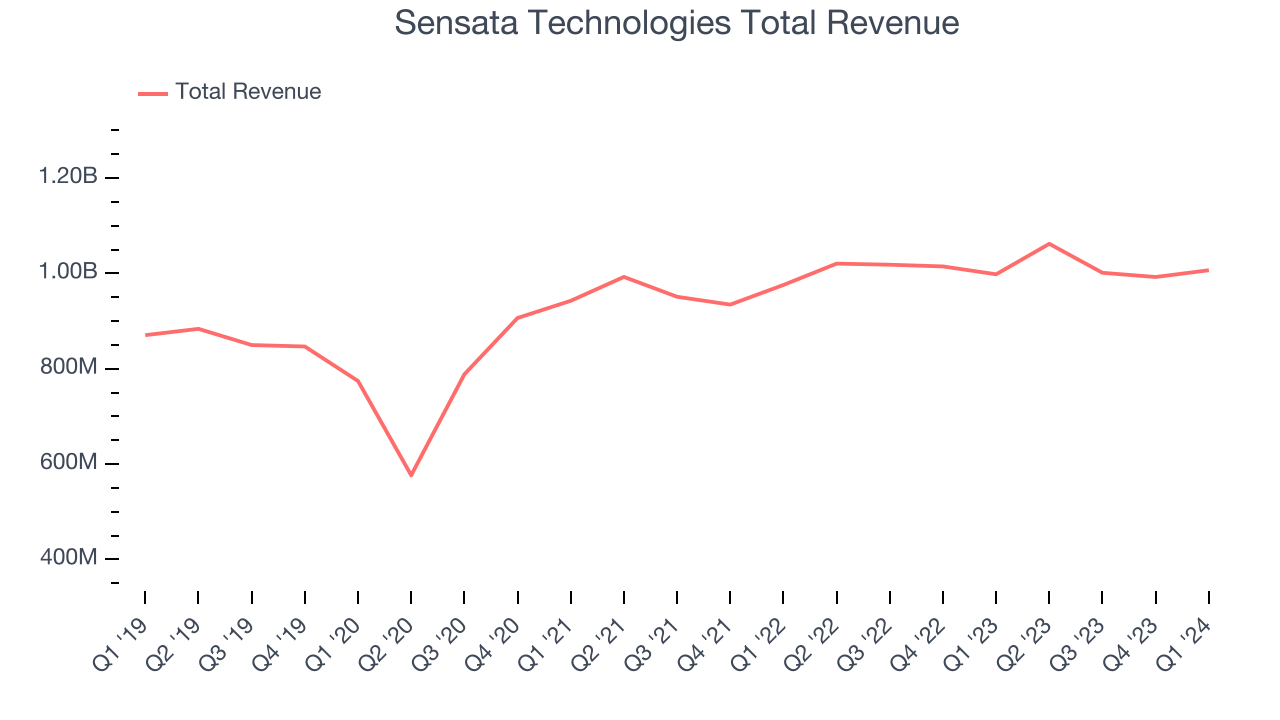
While Sensata Technologies beat analysts' revenue estimates, this was a sluggish quarter for the company as its revenue only grew 0.9% year on year. Sensata Technologies's growth, however, flipped from negative to positive this quarter. This encouraging sign will likely be welcomed by shareholders.
Although Sensata Technologies returned to positive revenue growth this quarter, its management team expects revenue to decline 2.1% next quarter. On the other hand, Wall Street expects the favorable trend to continue, projecting 3.2% revenue growth over the next 12 months.
Product Demand & Outstanding Inventory
Days Inventory Outstanding (DIO) is an important metric for chipmakers, as it reflects a business' capital intensity and the cyclical nature of semiconductor supply and demand. In a tight supply environment, inventories tend to be stable, allowing chipmakers to exert pricing power. Steadily increasing DIO can be a warning sign that demand is weak, and if inventories continue to rise, the company may have to downsize production.
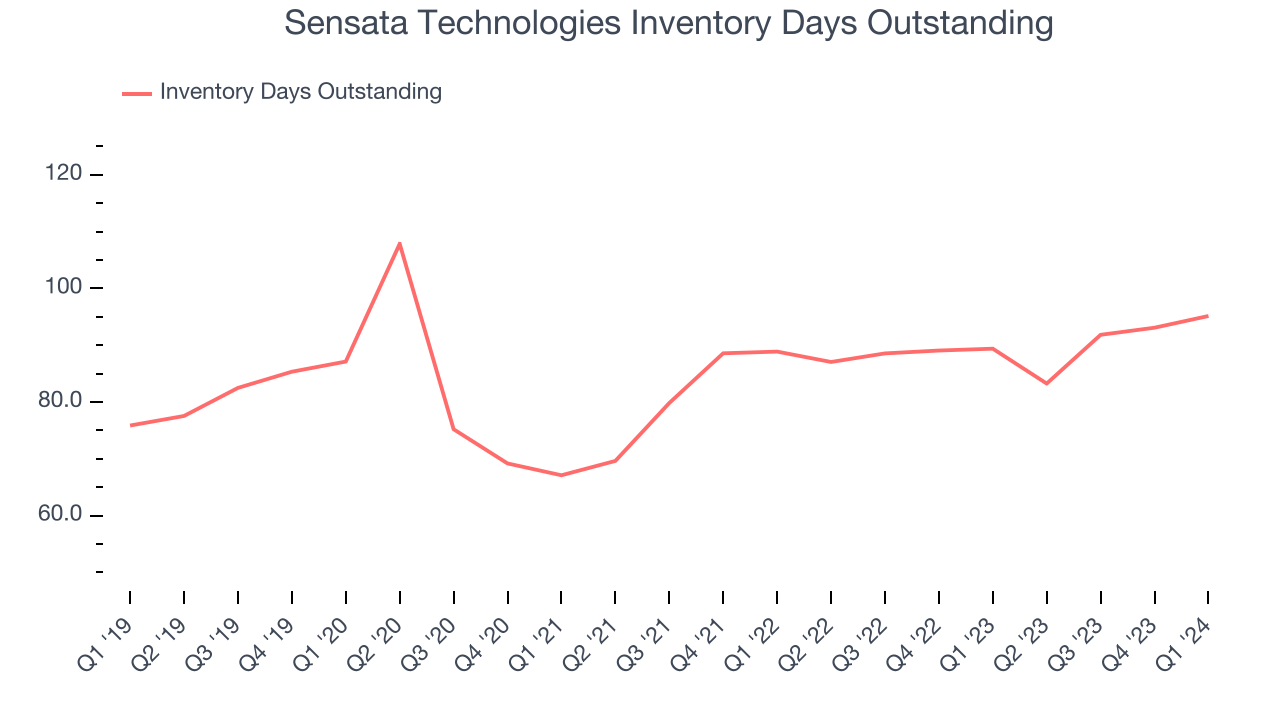
This quarter, Sensata Technologies's DIO came in at 95, which is 10 days above its five-year average, suggesting that the company's inventory has grown to higher levels than we've seen in the past.
Pricing Power
In the semiconductor industry, a company's gross profit margin is a critical metric to track because it sheds light on its pricing power, complexity of products, and ability to procure raw materials, equipment, and labor. Sensata Technologies's gross profit margin, which shows how much money the company gets to keep after paying key materials, input, and manufacturing costs, came in at 31.5% in Q1, down 1.3 percentage points year on year.
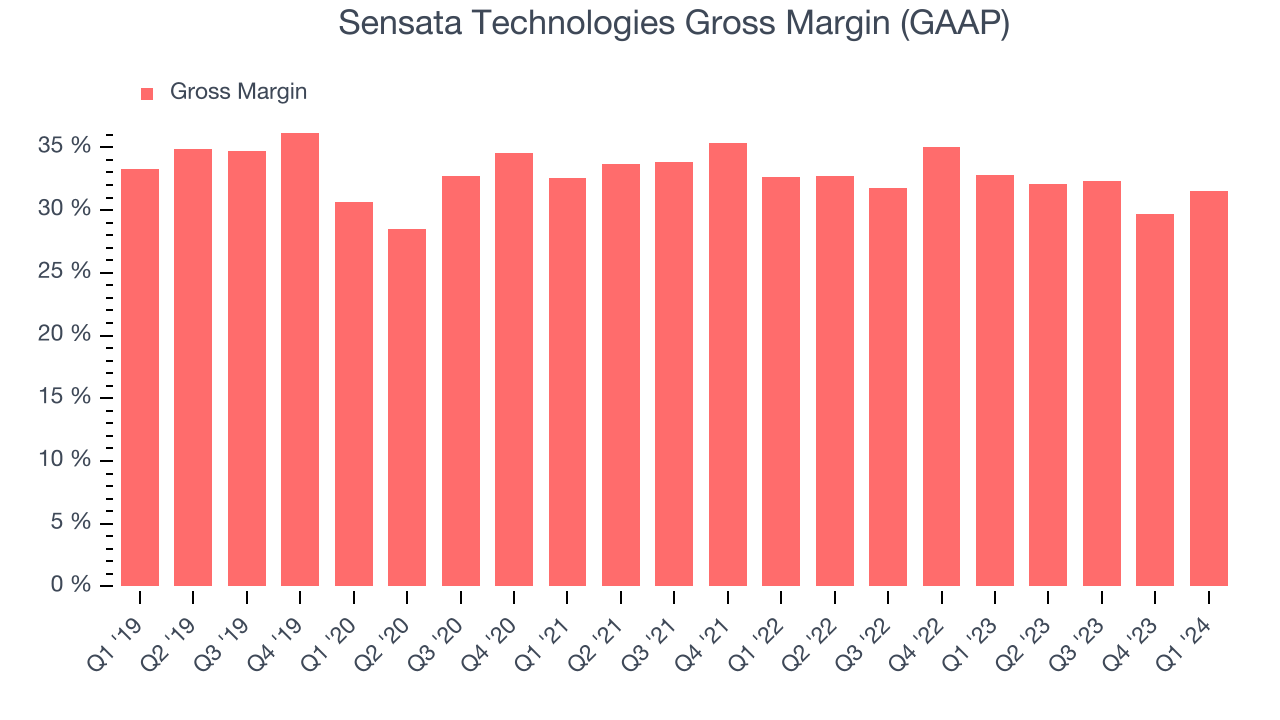
Sensata Technologies's gross margins have been trending down over the last 12 months, averaging 31.4%. This weakness isn't great as Sensata Technologies's margins are already far below other semiconductor companies and suggest shrinking pricing power and loose cost controls.
Profitability
Sensata Technologies reported an operating margin of 18.7% in Q1, down 0.6 percentage points year on year. Operating margins are one of the best measures of profitability because they tell us how much money a company takes home after manufacturing its products, marketing and selling them, and, importantly, keeping them relevant through research and development.
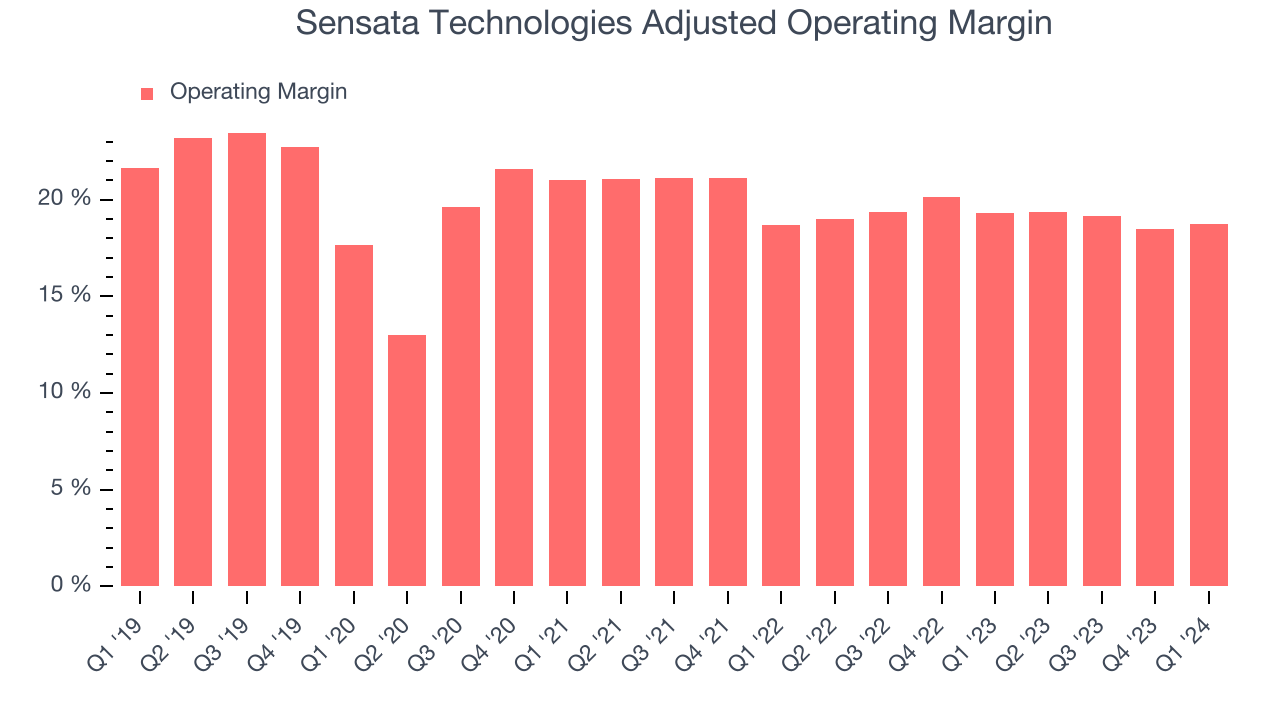
Sensata Technologies's operating margins have been trending down over the last year, averaging 18.9%. This is a bad sign for Sensata Technologies, whose margins are already below average for semiconductor companies. To its credit, however, the company's margins suggest modest pricing power and cost controls.
Earnings, Cash & Competitive Moat
Analysts covering Sensata Technologies expect earnings per share to grow 6.7% over the next 12 months, although estimates will likely change after earnings.
Although earnings are important, we believe cash is king because you can't use accounting profits to pay the bills. Sensata Technologies's free cash flow came in at $64.36 million in Q1, up 7.3% year on year.
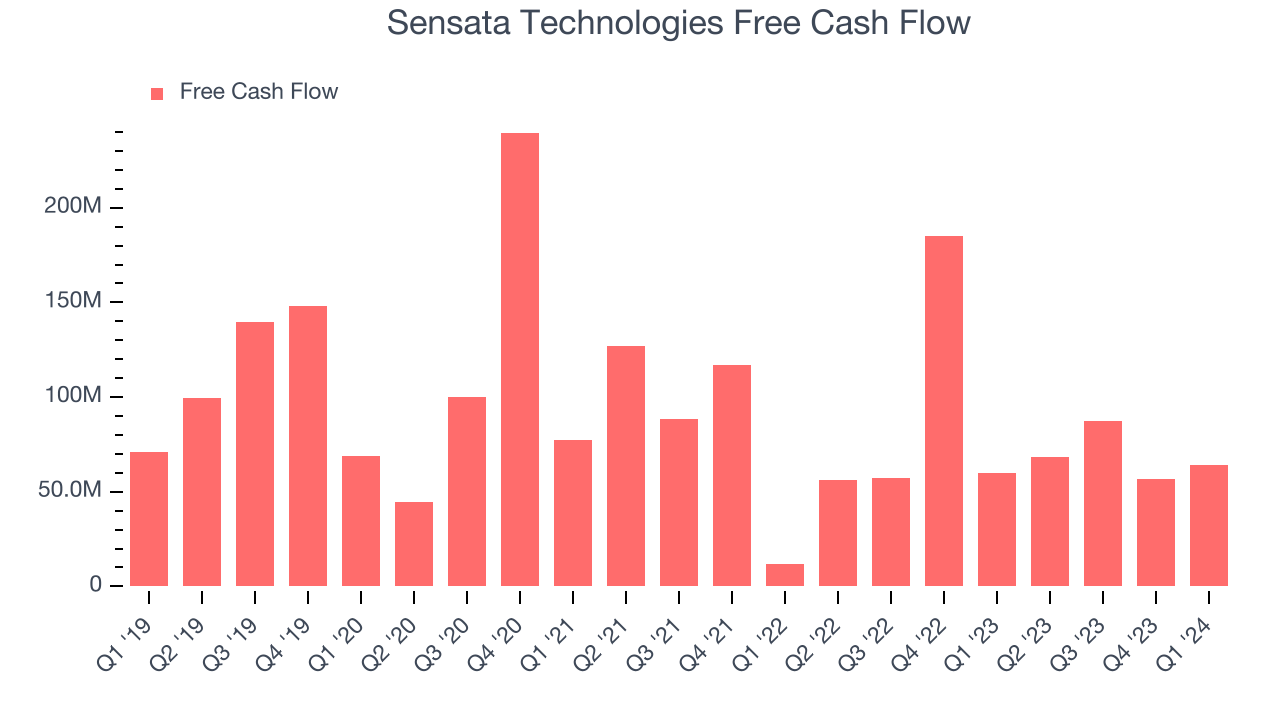
Sensata Technologies has generated $276.4 million in free cash flow over the last 12 months, or 6.8% of revenue. This FCF margin enables it to reinvest in its business without depending on the capital markets.
Return on Invested Capital (ROIC)
EPS and free cash flow tell us whether a company was profitable while growing revenue. But was it capital-efficient? Enter ROIC, a metric showing how much operating profit a company generates relative to how much money the business raised (debt and equity).
Sensata Technologies's five-year average ROIC was 7.5%, somewhat low compared to the best semiconductor companies that consistently pump out 35%+. Its returns suggest it historically did a subpar job investing in profitable business initiatives.
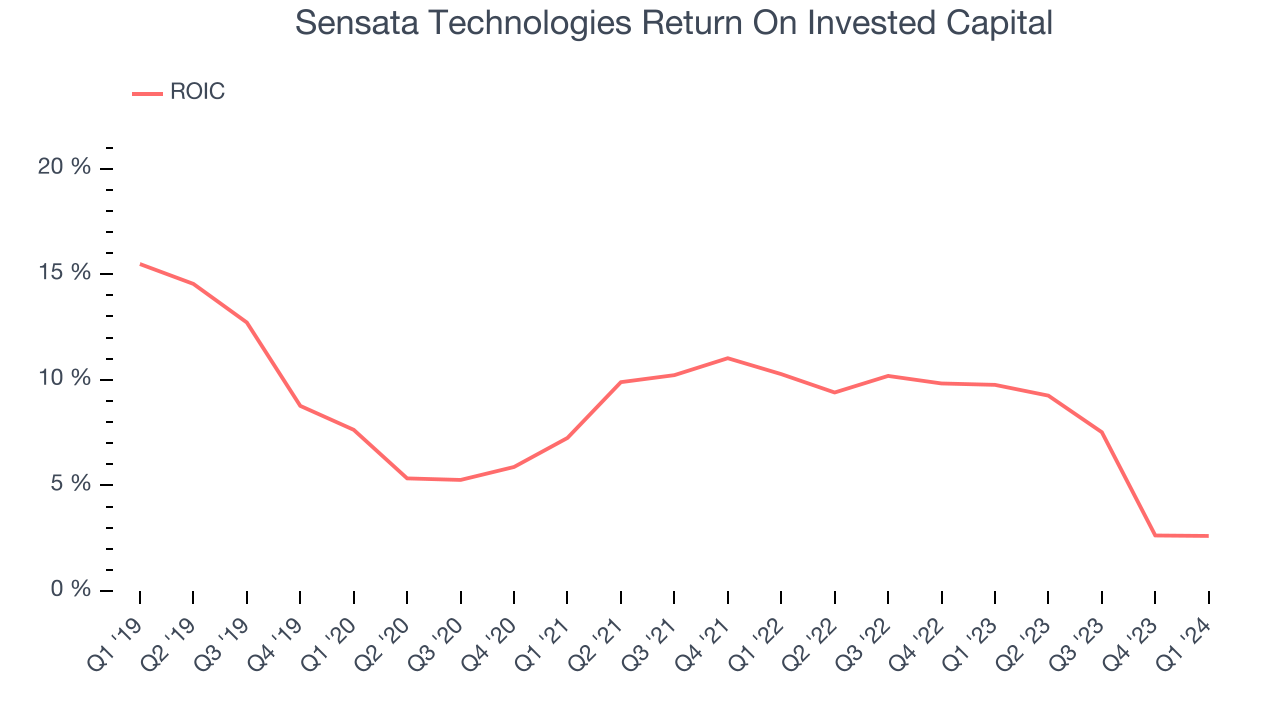
The trend in its ROIC, however, is often what surprises the market and drives the stock price. Unfortunately, Sensata Technologies's ROIC averaged 1.3 percentage point decreases over the last few years. Paired with its already low returns, these declines suggest the company's profitable business opportunities are few and far between.
Balance Sheet Risk
As long-term investors, the risk we care most about is the permanent loss of capital. This can happen when a company goes bankrupt or raises money from a disadvantaged position and is separate from short-term stock price volatility, which we are much less bothered by.
Key Takeaways from Sensata Technologies's Q1 Results
We enjoyed seeing Sensata Technologies exceed analysts' EPS expectations this quarter. We were also glad its revenue outperformed Wall Street's estimates. That guidance for next quarter was in line with expectations shows that this company is on track. Zooming out, we think this was still a decent, albeit mixed, quarter, showing that the company is staying on track. The stock is up 6.5% after reporting and currently trades at $38.03 per share.
Is Now The Time?
When considering an investment in Sensata Technologies, investors should take into account its valuation and business qualities as well as what's happened in the latest quarter.
We cheer for everyone who's making the lives of others easier through technology, but in the case of Sensata Technologies, we'll be cheering from the sidelines. Its revenue growth has been uninspiring over the last three years, but at least growth is expected to increase in the short term. On top of that, its relatively low ROIC suggests it has struggled to grow profits historically, and its gross margin indicate some combination of pricing pressures or rising production costs.
Sensata Technologies's price-to-earnings ratio based on the next 12 months is 9.4x. While we've no doubt one can find things to like about Sensata Technologies, we think there are better opportunities elsewhere in the market. We don't see many reasons to get involved at the moment.
Wall Street analysts covering the company had a one-year price target of $43.17 per share right before these results (compared to the current share price of $38.03).
To get the best start with StockStory check out our most recent Stock picks, and then sign up to our earnings alerts by adding companies to your watchlist here. We typically have the quarterly earnings results analyzed within seconds of the data being released, and especially for the companies reporting pre-market, this often gives investors the chance to react to the results before the market has fully absorbed the information.
